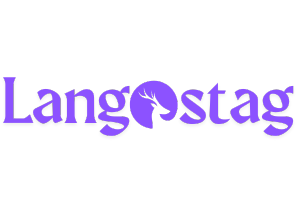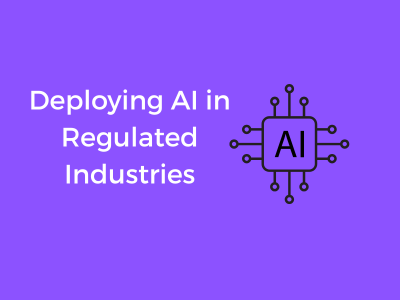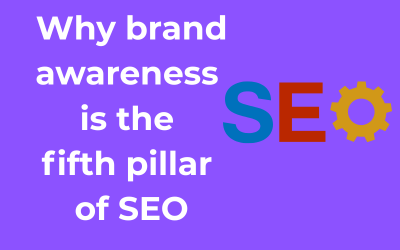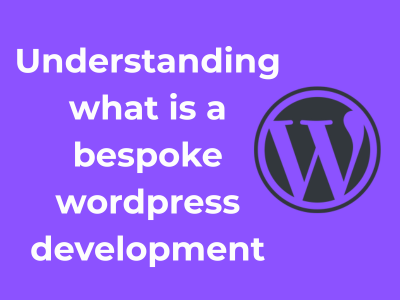When it comes to deploying artificial intelligence (AI) in regulated industries, striking the perfect balance between groundbreaking innovation and strict regulatory compliance is a challenge. But let’s be honest—no one said building the future would be easy! Creating AI systems that are both revolutionary and play by the rules requires a special mix of creativity, deep expertise, and an unwavering commitment to the public trust.
At LangStag, we’re keenly aware of this balancing act. We view regulations not as roadblocks, but as the guardrails that ensure AI works for people, not against them. Let’s break it down to show why this isn’t just a necessary evil—it’s actually a smart way to innovate.
Why Balancing Innovation and Compliance Matters
Imagine this: you’ve developed an AI solution that promises to transform healthcare or finance. Great, right? But what if deploying it without adhering to privacy standards or safety guidelines causes harm—or even triggers legal consequences? That’s where regulations come in. They serve as a safety net for both the creators and users of these cutting-edge technologies. It’s about responsible progress.
On the other hand, compliance alone isn’t enough. Sticking too strictly to the past without pushing boundaries can stifle innovation. After all, what’s the use of AI if it doesn’t explore new possibilities? This is why that equilibrium, that delicate dance between bold experimentation and sticking to regulatory frameworks, is critical for any forward-thinking company working in a heavily regulated space.

Lessons from the Trenches: Innovation Without Compromise
Over the years, LangStag has crafted a steady strategy to carve out this balance. Here’s what we’ve learned about navigating this tricky terrain:
- Start with a compliance culture: Before diving into the “fun stuff,” establish a compliance-first mindset across your team. At LangStag, everyone—from our developers to our sales teams—understands the importance of working within the rules. It’s a shared responsibility.
- Bring regulators into the conversation early: Instead of treating them as the “bad guys,” consider regulators as partners. Sharing your ideas with them upfront can make the compliance journey smoother and less stressful.
- Leverage technology to solve the compliance puzzle: We’ve discovered that building compliance features directly into our AI systems—like automated audit trails or security safeguards—makes life easier for everyone, regulators included.
Why Companies Need To Adapt, Not Resist
Let’s face it—regulatory requirements are only going to grow as more industries adopt AI solutions. And that’s a good thing! These laws force companies to innovate responsibly, which can lead to higher-quality outputs and stronger end-user trust.
Besides, adapting to regulations often leads to unexpected opportunities. At LangStag, we’ve frequently found that solving regulatory challenges pushes our team to think creatively, resulting in systems that are not only compliant but also more user-friendly, scalable, and trustworthy.
Understanding the Regulatory Landscape: From Challenges to Necessities
Hey there! Let’s dive into something that might sound a bit intimidating at first but is oh-so-crucial when it comes to deploying AI in regulated industries: the regulatory landscape. Trust us, it’s not just about jumping through legal hoops—it’s about creating dependable and responsible AI. The rules aren’t here to hold us back; they’re here to protect people and foster trust. So, let’s break it all down in a fun and approachable way.
Why Does the Regulatory Landscape Exist?
Before we get into the nitty-gritty, let’s zoom out a little. Regulations are essentially safeguards. They exist to ensure fairness, safety, and accountability, especially when new technology—like AI—enters industries like healthcare, banking, or transportation, where there’s little to no room for error. Imagine a self-driving car running software that hasn’t been properly vetted. Scary, right? That’s exactly the kind of scenario regulations are designed to prevent.
The main goal? Protecting humans, whether it’s their privacy, safety, or basic rights. That’s why robust regulatory frameworks aim to balance the pace of AI innovation with the responsibility of deploying it ethically and safely.
The Key Challenges in Navigating Regulations
Alright, we get it—rules can sometimes feel stifling. But understanding them is half the battle. Some of the challenges companies face when working in these regulated spaces include:
- Evolving Policies: AI development moves quickly, but laws and policies sometimes take their sweet time catching up. Keeping up with changing laws is like chasing a moving target.
- Global Variations: Regulations differ from country to country—or even state to state—making compliance a constant game of adaptation for global companies.
- Complexity: Legal jargon and ambiguous requirements can make it difficult for developers to figure out what they actually need to do to comply.
Does that sound like a lot? It can be, but with proactive planning and the right mindset, navigating these challenges becomes much smoother.
Regulations Aren’t Just Obstacles; They’re Opportunities
Here’s the secret sauce: approaching regulations with a positive frame of mind can turn them into a competitive advantage. When your AI systems are compliant and trustworthy, it builds credibility and earns the confidence of customers, clients, and governments alike.
Here are some of the opportunities hidden in the compliance-first approach:
- Enhanced Trust: Meeting compliance standards demonstrates your commitment to playing by the rules, helping your clients feel safer using your platform.
- Long-Term Reliability: Building an AI system that’s regulation-ready reduces the risk of legal issues later, saving both time and money.
- Market Access: Compliant solutions are often the gateway to operating in strictly regulated industries or new geographic regions.
Why Proactive Learning About Regulations Is Key
At the end of the day, you don’t want to treat compliance like an afterthought. Instead, understanding it early on can influence your design and development process for the better. For AI, particularly, you always need to ask: “Does this serve the humans it’s intended for—and does it meet the current rules?”
Remember: it’s less about avoiding penalties and more about creating products that are ethical, reliable, and future-proof.
LangStag’s Approach to Risk Assessment in AI Implementation
When you hear the term “risk assessment,” you might picture a room full of people analyzing spreadsheets, forecasting possible dangers lurking around the corner. While that’s not entirely incorrect, LangStag takes risk assessment in AI implementation to a whole new level. Let’s chat about how this forward-thinking approach works and why it’s worth emulating.

Why Risk Assessment in AI Is Non-Negotiable
Artificial Intelligence is like a double-edged sword—capable of groundbreaking innovation but equally capable of unintended slip-ups. In regulated industries, these mistakes can have far-reaching implications, including legal penalties, privacy violations, or even public trust erosion. Risk assessment isn’t just a checkbox for LangStag; it’s the foundation of their compliance-focused development strategy.
LangStag recognizes that every AI system is a combination of data quality, algorithm design, human use, and external factors. Each of these components can introduce its own set of risks. That’s why they’ve built a methodical and proactive approach to identify potential pitfalls before they materialize. It’s like being three steps ahead in a chess game—the stakes just happen to be much higher!
The LangStag 3-Step Risk Assessment Process
Now, let’s break it down. Here’s how LangStag structures their AI risk assessment to make sure everything stays on the up-and-up:
- Understanding Context: Any AI solution needs to live in the real world. LangStag starts by conducting a deep dive into the specific regulations and potential risks tied to the industry they’re developing for. For example, the needs of a healthcare company differ sharply from those of a financial institution. This context-focused approach ensures tailored compliance strategies.
- Identifying Risk Points: Once the playing field is mapped out, LangStag conducts a comprehensive evaluation of where risks might arise. From biases in training data to potential algorithm misuse, nothing escapes scrutiny. They apply scenario planning to model different “what if” situations, ensuring they have a robust understanding of possible issues.
- Implementing Safeguards: Identifying risks is only half the game. LangStag implements monitoring systems and compliance checkpoints throughout the AI’s lifecycle. Think of this as a safety harness for their projects—every step has a built-in mechanism to detect and mitigate risks before they become a problem.
Collaboration: The Secret Sauce
One unique aspect of LangStag’s approach is their collaborative engagement with stakeholders. Risk assessment isn’t handled in isolation. Teams include not only AI engineers but also compliance experts, legal advisors, and representatives from the regulated industry itself. This multidisciplinary model ensures diverse perspectives are accounted for, covering risks that might otherwise be overlooked.
LangStag also believes in keeping open lines of communication with regulatory bodies. By aligning project objectives with legal frameworks from the get-go, they avoid costly redesigns or compliance roadblocks later.
The Payoff: A Stronger, Safer Future
In the end, LangStag’s approach to risk assessment isn’t just about managing the present—it’s about future-proofing their AI solutions. By prioritizing risk management, they position themselves as leaders in creating ethical, regulation-ready technologies. It’s a strategy that’s not just smart; it’s essential in today’s rapidly evolving landscape.
Why Data Privacy Is at the Heart of AI Development at LangStag
In today’s digital world, data is the lifeblood of innovation, especially when it comes to artificial intelligence. But let’s be real—without proper care, it can also be a ticking time bomb. At LangStag, we’ve made it our mission to ensure that data privacy isn’t just an afterthought; it’s the foundation of everything we do. It’s not just about meeting regulations—it’s about earning and safeguarding trust.
Data Privacy: More Than a Legal Requirement
Sure, adhering to privacy laws like GDPR, CCPA, or other regional regulations is non-negotiable. But at LangStag, data privacy isn’t just about checking boxes. It’s about understanding that every data point represents a person—someone who trusts us to handle their sensitive information responsibly.
At the core of LangStag’s AI development is a simple but powerful idea: respect for data ownership. We believe individuals should have control over their information, and that belief shapes how we collect, process, and store data. This human-centered approach not only complies with regulations but also fosters loyalty among users and industry partners.
How LangStag Protects Your Data
Ever wonder what “privacy by design” actually looks like? Let’s break it down for you. Here are some ways LangStag bakes data privacy into every stage of AI development:
- Encryption Is the Default: We use advanced encryption techniques to keep all data safe, both in transit and at rest. Think of it like putting your valuables in a vault before they even leave the house.
- Minimal Data Collection: Why collect more data than you need? We follow a “data minimization” principle, ensuring our AI systems only use the absolute essentials.
- Anonymization and Pseudonymization: Sensitive data is anonymized whenever possible. This ensures any stored information can’t be easily traced back to an individual.
- Access Controls: Tight role-based permissions ensure that only authorized personnel—who actually need to work with the data—can access it.
Transparency: The Key to Trust
One of the cornerstones of LangStag’s approach is transparency. We believe users and customers should always understand:
- What data is being collected
- Why it’s being collected
- How it will be used
To that end, we provide easy-to-read privacy notices and clear opt-in mechanisms. We want people to feel informed and empowered—not daunted by pages of legalese.
Building for Tomorrow
As AI continues to shape the future, data privacy will become even more crucial. Emerging technologies like federated learning and differential privacy enable processing data without ever exposing identifiable information. LangStag is committed to integrating these advances to protect data privacy proactively.
Integrating Ethical AI Practices in Highly Regulated Sectors
Hey there! If you’re exploring how artificial intelligence (AI) can thrive within highly regulated industries, you’ve landed in the right space. Let’s chat about why embracing ethical AI practices isn’t just a nice-to-have for businesses like LangStag—it’s an absolute must. We’ll uncover how ethics and compliance blend into the fabric of AI implementation for greater success, safety, and trustworthiness. Shall we?
What Does ‘Ethical AI’ Even Mean?
When we talk about ethical AI, we’re essentially discussing tech that’s designed to do the right thing—both for people and society. Sounds simple, right? But here’s the catch: for industries steeped in regulations (think finance, healthcare, law, etc.), “the right thing” is a multi-layered challenge. Ethical AI ensures outcomes that align with fairness, transparency, accountability, and inclusivity, while steering clear of harm or bias.
So, how exactly does LangStag navigate these tricky waters? Glad you asked!
Paving the Ethical AI Path at LangStag
LangStag takes ethical AI development seriously—there’s no room for shortcuts when compliance is part of the game. Here’s how they make it happen:
- Respect for Human Rights: LangStag prioritizes AI systems that protect individuals and promote equality. Discrimination or bias? Never invited to the party.
- Clear and Transparent Decision-Making: Ever felt a little uneasy about mysterious algorithms making decisions that impact you? LangStag ensures AI systems remain as transparent as those squeaky-clean glass doors at your favorite café.
- Accountability: Mistakes happen—even with AI. LangStag has procedures to assess responsibility and adapt systems when needed. Owning up is part of the plan.
- Beneficial Outcomes: AI should make lives better, not worse. LangStag only designs solutions that add meaningful value to the industries they serve. Profit doesn’t come at the expense of social welfare—no way!
The Heavyweights: Principles and Policies
Here’s where things start connecting to those serious regulations. LangStag carefully incorporates international ethical frameworks—like GDPR for privacy or ISO standards for AI—in their AI systems. Essentially, LangStag’s a rule-following whiz when it comes to creating tools that meet both legal *and* ethical standards.
“Sounds cool, but how do they test it all?” you might be wondering! Well, LangStag engages with a variety of stakeholders ranging from subject-matter experts to community advocates to ensure they get it absolutely right.
Case in Point: How Ethical AI Saves the Day
You’d be surprised at how applying ethical AI principles head-on can create ripple effects on safety and trust. For instance:
- A finance AI tool designed with transparency ensures users understand—and trust—the decisions made about their credit scores.
- An AI-powered diagnostic system for healthcare protects patient rights by eliminating biases and reducing unequal treatment outcomes.
In both cases, LangStag’s commitment to ethical AI not only keeps them compliant but also sets a gold standard other companies can look up to.
The Bottom Line: Ethics Build Bridges, Not Barriers
So, why is this important? Because ethical AI is like the secret sauce of compliance-driven industries—it delivers competitive advantages while securing public trust. The takeaway? When AI is built ethically, everyone wins. LangStag shows how combining smart tech with thoughtful practices can make a regulated world a whole lot more innovative without cutting corners.
Real-Life Applications of LangStag’s AI: Maintaining Compliance in Action
There’s something magical about seeing theory turn into real-world magic, isn’t there? At LangStag, all the behind-the-scenes dedication to compliant AI development comes to life in some truly inspiring applications. Let’s paint a picture of how LangStag’s AI solutions make waves in highly regulated industries while keeping compliance front and center.
Mitigating Financial Risks in the Banking Sector
Picture this: a world where banks can provide seamless, efficient service while meeting stringent government regulations. LangStag’s AI systems make this a reality. By automating processes like fraud detection, transaction monitoring, and risk assessment, financial institutions gain an edge in combating cyber threats.
Here’s the twist! Not only do LangStag’s solutions detect irregular patterns in vast datasets faster than humans ever could, but they also ensure the AI operates within compliance boundaries like anti-money laundering (AML) directives. That’s a win-win for financial security and keeping regulators happy.
Compliance in Healthcare: Speed Without Sacrificing Safety
In the healthcare sector, compliance isn’t just a checkbox; it’s a matter of life and death. LangStag brings its AI expertise to hospitals and pharmaceutical companies, ensuring data privacy and adhering to tight regulations like HIPAA or GDPR. For example, analyzing patient data to identify early signs of diseases like diabetes can be executed without compromising sensitive personal information.
How? These AI tools employ secure data handling processes, ensuring only authorized personnel access patient details. LangStag takes pride in enabling healthcare providers to innovate safely, saving lives while respecting privacy laws every step of the way.
Supply Chain Compliance: AI on the Move
Ever wondered how large corporations ensure their operations meet environmental laws and social responsibility standards? LangStag’s AI bridges the gap here by auditing supply chain processes in real time. From checking whether materials are sourced ethically to ensuring adherence to environmental protection regulations, LangStag’s algorithms tackle compliance challenges head-on.
- Example: Imagine a scenario where LangStag’s AI identifies a vendor using non-compliant materials. The system immediately flags it, allowing the company to act quickly and avoid hefty fines or damage to its reputation.
Empowering Regulated Industries Through Proactivity
One of LangStag’s standout features is how proactive its AI solutions are. Instead of responding to compliance crises after they occur, these tools anticipate regulatory changes. For instance, if energy sector regulations shift toward stricter carbon emission reporting, LangStag’s AI adjusts analytics tools to ensure smooth compliance well in advance.
Not waiting for the other shoe to drop? That’s some superhero-level prevention!
What Makes LangStag Unique?
What sets LangStag’s AI apart is its ability to weave compliance into each decision and process without stifling innovation. It’s no small feat to stay agile in industries where rules are written in stone, but LangStag makes it look effortless through customized, cutting-edge technologies developed with care.
Monitoring and Updating AI Systems to Stay Regulation-Ready
Hey there! Let’s talk about something that might not sound super exciting at first – monitoring and updating AI systems – but trust me, it’s incredibly important, especially when working within regulated industries. The world of compliance is constantly shifting, and to keep AI systems in check, LangStag has mastered the art of adapting to these changes without missing a beat.
Why Regular Monitoring is a Non-Negotiable
Okay, let’s be real. Regulations in industries like finance, healthcare, and law don’t just sit still. They’re always evolving to address new concerns or tighten controls. What might be compliant one day could become outdated the next. That’s why constant monitoring of AI systems is non-negotiable. At LangStag, we’ve incorporated continuous assessment as a core part of the AI lifecycle.
Think of it like maintaining a car. You’d never drive around with worn-out brakes or outdated safety standards, right? The same mindset applies here. LangStag ensures that our AI systems always run smoothly and meet the latest safety, ethical, and legal guidelines.
The Tools Behind the Magic
Let’s dive into some of the methods we use to keep an eye on our AI’s performance and compliance:
- Automated Compliance Checkers: These tools scan AI systems regularly to flag any potential compliance risks. They’re like digital detectives catching issues before they turn into real-world problems.
- Performance Dashboards: LangStag’s in-house dashboards provide constant insights into how AI systems are operating. If something seems off, we act swiftly.
- Regular Audits: Nothing beats human expertise. Periodic audits conducted by specialists ensure everything is running in line with both regulations and ethical standards.
By blending smart technologies and human oversight, we strike an efficient and reliable balance.
Updating with Confidence and Care
When updates are needed (and let’s face it, they always are), LangStag follows a meticulous process to ensure these changes don’t create a ripple effect of risk. Here’s how we approach updates like pros:
- Scoping the Update: First, we pinpoint exactly what needs to change. Is it compliance-related? A new ethical standard? Or just an improvement?
- Impact Analysis: Before making any adjustments, we carefully assess how the update will influence existing systems and processes to avoid unintended consequences.
- Testing in Sandboxes: No code goes live until it’s been thoroughly tested in isolated environments. Safety first, always!
- Transparent Rollouts: Whenever updates are implemented, stakeholders are kept in the loop with clear, jargon-free communication.
Staying Ahead in a Fast-Changing World
The secret to staying regulation-ready isn’t just reacting to changes. Proactively anticipating them is where LangStag really excels. By staying plugged into industry updates, maintaining close partnerships with regulators, and fostering a culture of ongoing learning, we ensure we’re always two steps ahead.
So, next time you think about AI monitoring or updates, remember that it’s more about being future-ready than just clocking a checkbox. It’s about leading with responsibility and setting gold standards in compliance, and at LangStag, we’re here to pave that path one regulation-ready system at a time. Exciting stuff, right? Who knew compliance could be this empowering!











